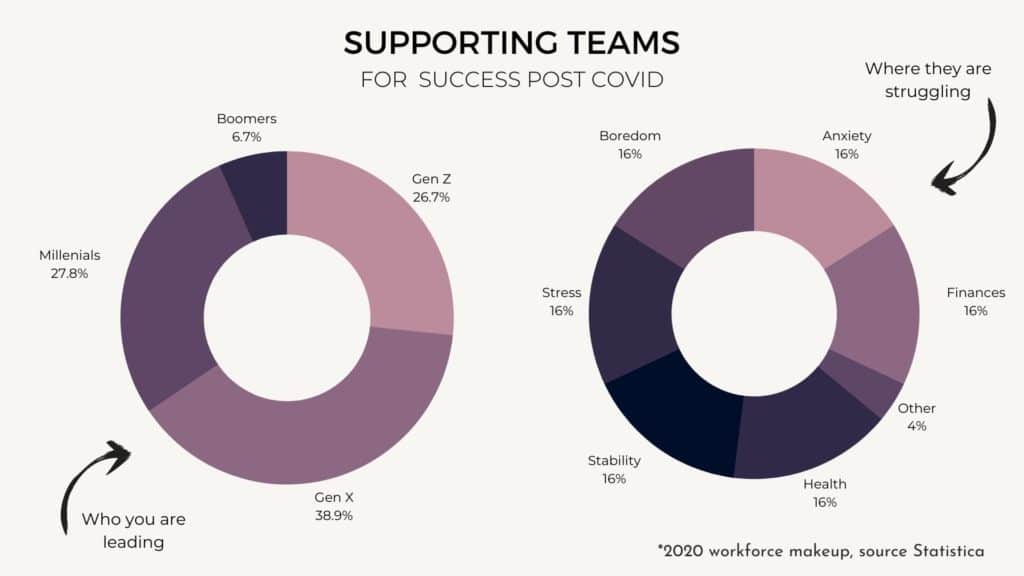Leadership in a Post Covid Workplace
If you read our piece on leading through the generations a few months ago, then you know that everything has changed since then! We are now entering a post Covid workplace and people are feeling all the feelings. Leadership in a post covid workplace will be tricky. Depending on the person, they may be ready to get back to business like it was 2019 and others may need some accommodations. In fact, just yesterday #nobodywantstoworkanymore was trending on Twitter discussing that businesses are closed because they can’t retain current talent and they don’t have enough staff to keep the doors open.
Why? Because people are burned out, feeling betrayed, and undervalued when the expectation and/or messaging is, “The pandemic is over! Now we can get to work.” (Forgetting that the pandemic was anything but a restful break and that minimum and fair wages are still an issue.)
If you are someone leading a team, that means you’re in a space where you have to produce AND keep spirits high (plus maintain your own mental health). My best advice is to create a plan that accommodates everyone on the team.

Before we get into some research and tips, remember to check the pulse of your team. Everyone is dealing with different stressors and are at different stages of their lives. The only way to be a great leader is to get to know your team and figure out how you can support them individually. Talk to your team. Ask questions. Listen. Then use their responses and the suggestions below to help you determine the best way to move forward.
Generation Z (ages 18 to 23)
Gen Z was most affected by unemployment during covid (Reuters 2020). The fact that they were the youngest generation made them enter the workforce at the worst possible time. Many of them may be ready to go back to normal and start their new careers. This does not mean that they come out of a global pandemic with a fresh mind and clean slate. Many of them face the reality of a bad economy and tight finances. According to Pew Research Center, 52 percent of young adults (ages 18- to 29- years-old) in the U.S. now live with their parents. This means that their mental health may suffer when adding work demands.
How can you help Gen Z?
Gen Z will benefit from a mentorship program that shows them that there is light at the end of the tunnel. It would be important for them to know that leadership is supporting them and creating a plan for them to grow within the company. Another way Gen Z (and others) can use support is by prioritizing mental health. This can be as simple as creating a policy for using mental health days or making sure people know what resources are available and how to access them. (FYI – Even outside resources are valuable to your team. It also shows you recognize where they may need additional support and providing access or recommendations demonstrates you care about their well being.
Generation X (41-56 years old)
According to Fast Company gen X leaders now hold more than half (51%) of leadership roles globally. Gen X 18% lost their jobs (source Linkedin). Gen Xers also had to deal with navigating parenting and caring for elderly parents more through the pandemic, so the burnout rate might be high. It may also mean that as schools are opening up and the people are getting vaccinated – they may be ready to run back to the office to socialize!
How can you help Gen X?
You can start by providing them with some flex time. Acknowledge that you appreciate all their hard work while juggling so many important roles the last year. They may prefer working remotely a few days a week or just shifting their traditional work day schedule. Another way to help the transition is by bringing back some fun! Try scheduling a Virtual Office Olympics Day or even using some fun apps (like Donut) on Slack for the team to get to know each other better. Reminding people of what a good work culture feels like will always help productivity.
Baby Boomers (ages 56 – 74)
If you have any Baby Boomers as talent, they are probably in leadership roles or close to their retirement age. This can be great for leadership, because they will most likely stay loyal to your company. On the other hand, they could be affected by what we called senior-itis in high school. They have one foot out the door and so their performance may begin to suffer. They may also still have reservations about going back to work in-person.
How can you help Baby Boomers?
Make sure to keep Baby Boomers engaged by providing challenging leadership opportunities. Involve them in your hiring or onboarding process so that they can mentor new talent. Also make sure to remain flexible with your remote working policies (for everyone). You want to make sure people feel safe and valued, so give them the space to choose where they want to work from.
Final thoughts
As you navigate leadership in a post covid workplace, know that there is not a one stop solution. Although generational differences will impact people, so will their unique lifestyles. As we get back to business, we know that some things will always be the same. Happy employees will create a positive work environment, and we can all use some extra happiness after 2020.
As you adjust to all these changes make sure you download my Navigating Change Roadmap to support you each step of the way.





